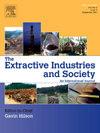锂三角的开采:面对气候、治理和社会环境挑战的资源开发的多方面方法
IF 4.3
2区 社会学
Q2 ENVIRONMENTAL STUDIES
Extractive Industries and Society-An International Journal
Pub Date : 2025-08-28
DOI:10.1016/j.exis.2025.101761
引用次数: 0
摘要
考虑到对绿色能源技术的需求,能源转型带来了重大挑战。在这种情况下,开采锂等战略性或关键矿物对于实现净零目标至关重要。本研究旨在分析决定该行业发展的因素,特别是在阿根廷、玻利维亚和智利的盐滩。提出了一种根据公开数据评估每个因素的方法,以评估资源开发的潜力。在地质潜力方面,玻利维亚在分析的国家中潜力最大。在治理方面,智利拥有最好的采矿监管框架,但对于锂开发来说,这可能被夸大了。在社会环境因素方面,玻利维亚在社会环境冲突方面的平均得分最高,而阿根廷最低。最后,气候结果表明玻利维亚受干旱和极端降水威胁的影响最大。研究结果表明,各因素对锂矿开采的影响程度不同,其中地质潜力和治理因素对锂矿开采的发展起着重要作用。对于预期的气候灾害,结果表明,气候变化潜在影响的增加与项目开发的减少无关。本文章由计算机程序翻译,如有差异,请以英文原文为准。
Mining in the lithium triangle: A multifaceted approach towards resource development in the face of climate, governance, and socio-environmental challenges
Considering the need for green energy technologies, the energy transition poses a material challenge. In this context, mining strategic or critical minerals like lithium is crucial to meeting net-zero targets. This study aims to analyze the elements determining the development of this industry, specifically in salt flats in Argentina, Bolivia, and Chile. A methodology to assess each factor based on publicly available data is proposed to assess the potential for resource development.
Regarding geological potential, Bolivia is found to have the highest potential among the analyzed countries. In terms of governance, Chile has the best regulatory framework for mining, but this might be overstated for lithium development. Regarding the socio-environmental factor, Bolivia has the highest average score for socio-environmental conflicts, while Argentina has the lowest. Finally, climate results indicate that Bolivia is most affected by drought and extreme precipitation threats. These findings suggest that each factor affects lithium mining differently, with the geological potential and governance factors playing a significant role in reflecting the development of lithium mining. For expected climate hazards, results indicate that a higher potential for impacts from climate change is not related to lower project development.
求助全文
通过发布文献求助,成功后即可免费获取论文全文。
去求助
来源期刊

Extractive Industries and Society-An International Journal
ENVIRONMENTAL STUDIES-
CiteScore
6.60
自引率
19.40%
发文量
135
 求助内容:
求助内容: 应助结果提醒方式:
应助结果提醒方式:


